Tamela Rich's Blog, page 6
October 5, 2015
Explore Your Fears on “Face Your Fears Day”
Researching my new book on fear I’ve learned that psychologists classify any and all fears as one of these five:
Humiliation
Separation
Loss of Autonomy
Mutilation
Death
Five universal fears in three areas of life
I’m working with a Ph.D. statistician to conduct a survey that explores the five universal fears in three areas of life: Intimate relationships, Community, and Workplace.
In conjunction with “Face Your Fears Day” on Tuesday, October 13, I invite you to share your fears in an online survey. It takes less than 10 minutes to complete (I promise).
The deadline for survey responses is 7:00PM EST on Sunday, October 18. The survey results will be announced around Friday, November 13—note the significance of that date?
I need some help (from you) identifying trends. For example, is the most common fear in intimate relationships separation? In our workplaces, do we fear loss of autonomy more than we fear humiliation?
Discovering your “Fear Voice”
I’ll use what I’ve learned from the survey to develop a quiz that enables responders to identify their own “Fear Voice.”
If you know that, for example, your dominate fear in intimate relationships is ‘separation,’ you can begin to see the ways in which you behavior anticipates being separated.
People often believe things are going on in their lives because they fear them, not because they are real. Self-knowledge is the first step to a less fear-filled life.
Sign up here and never miss an update from me on this project or others!
Sign me up, Tamela!
Email Address
First Name
Optional Subscriptions
Weekly Blog Digest
Daily Getaway
The post Explore Your Fears on “Face Your Fears Day” appeared first on Tamela Rich.

September 28, 2015
Thoughts on Managing a Working Vacation
While I love exploring the country, there’s a lot to be said for staying in one place.
Yesterday we left the beach house that we’ve been fortunate to visit for the past 20 years. It’s become a touchstone for our lives, like children’s height notches on a closet door.
It’s tempting to work all the time and our culture rewards workaholics, but this week I wanted to truly unwind with my family. To “Connect Deep.”
And yet, I had a bit of work to do.
This is the push-pull of modern life. Many of us take “working vacations” and come away not feeling we got much of either done.
Finding balance
I want to share how I managed to both unwind and connect with my family, and also get my work done. What I learned could help you on your next vacation or your next weekend—or tomorrow night after you come home from your workplace.
My technique is called “being present.”
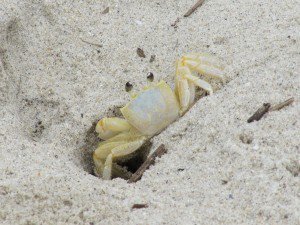 For example, when I sat on the beach and found my thoughts straying to my new book (read the news here) I practiced noticing that I was not fully present to the world around me. I then mindfully brought my attention to my surroundings.
For example, when I sat on the beach and found my thoughts straying to my new book (read the news here) I practiced noticing that I was not fully present to the world around me. I then mindfully brought my attention to my surroundings.
First, I noticed the funny ghost crabs scuttling from hole to hole in the sand, their eyes perched above their bodies like flower stamens. I tuned into gull cries and the rhythm of the waves. Being present is a technique we learn in meditation and yoga, for those of you who also have these practices.
On the other hand, when I was at work in the beach house, I would occasionally daydream about how great it would be out on the shore instead of inside. When I caught myself at this, I again mindfully came back to my work with a reminder that the sooner I finished the sooner I’d be on the beach.
How about your weekends?
How many times do we spend our weekends thinking about work? Too many. If you’re going to think about your work instead of decompressing from the work week, you might as well pitch a tent there and kiss your life goodbye.
Sure, there are times when you have crushing deadlines and surprises. If this is a way of life instead of its exception, please seek a balancing technique that will give you a sense of joy each day.
Godspeed.
The post Thoughts on Managing a Working Vacation appeared first on Tamela Rich.

September 14, 2015
Why Visit a West Virginia Coal Mine?
We all do it. We drive the same stretch of road time and again, never stopping to see what those “little brown signs” are enticing us to visit along the way.
With family in Ohio, I’ve traveled from Charlotte on I-77 through West Virginia at least 50 times. I was always interested in what was behind the little sign that said “Exhibition Coal Mine” at the city of Beckley (Exit 42) but told myself I didn’t have time to explore it.
Silly me. It was worth the layover! Heeding my own advice to “Travel Slow,” here are my reflections.
A coal mine vacation?
WBTV’s John Carter and I joked about taking a “vacation” in a coal mine (see the video at the top of this post). All joking aside, the Exhibition Coal Mine is fascinating from the perspectives of history, economics, avarice, technology, and the human spirit. It’s all right there.
The Beckley property once served as a working coal mine but closed in 1910. The city of Beckley grew up around the mine’s entrance, and developed a city park in the area around it. Then someone got the bright idea to rehabilitate the place as a tourist attraction, which opened to visitors in 1960.
Re-creating a coal camp
To accurately represent life in a turn-of-the-twentieth century coal camp, Beckley relocated buildings from other West Virginia mining operations: the coal company house, the superintendent’s home, Pemberton’s Coal Camp Church, and the Helen Coal Camp School.
You can tour a one-room miner shanty, which would have been rented by bachelor miners, and a three-room house that families would have lived in and perhaps taken in renters. Both are much cleaner than they would have been in real life, and docents answer your questions. The 14,000 square foot company store cum visitor center/museum is terrific (seen in the video below).
Modern day miners (retirees) serve as mine tour guides and if you watch the entire 23 minutes of the video I compiled, you’ll see that my guide “Kenny” is both witty and candid about conditions; quite a balancing act.
Click here to view the embedded video.
Confronting economic slavery
You will appreciate the sacrifice of our ancestors in a very different way once you confront their hardscrabble lives.
The grip that coal mining companies had on workers and their families was economic slavery, and it’s probably no coincidence that the rise of King Coal began near the end of the Civil War, when outright slavery (and de facto slavery) was still widespread.
This website offers a thumbnail sketch of life in the mines and coal camps. One historian has suggested that during World War I, a U.S. soldier had a better statistical chance of surviving in battle than did a West Virginian working in the coal mines.
Not all doom and gloom
Mining, and its representation in Beckley, is not all doom and gloom, however. In a tribute to the human spirit you’ll be inspired by the ways people made do with nothing and created community and solidarity. My grandfather and great-grandfather worked in Kentucky coal mines, so my visit brought me closer to my own family history.
The Beckley mine and coal camp give families a terrific shared experience from which to have meaningful conversations about a variety of topics. Don’t pass it by. No matter your economic circumstances, you’ll come away feeling you’ve got it “pretty good” as a twenty-first citizen of the so-called “first world.”
Think of that next Labor Day.
A family-friendly destination
The Exhibition Coal Mine is a family-friendly destination, but I’d recommend the mine tour for kids in third grade and above. Babies who fuss or toddlers who need to move about would not be good mine visitors because everyone needs to stay in the rail cars.
WARNING: at one point in the mine tour (you’ll see it in my video) you will be in utter darkness for perhaps 20 seconds.
If you are claustrophobic, the mine experience is not for you, but there is plenty to enjoy in the coal camp and visitor center, open April 1 through November 1.
Coal occurs in 53 of West Virginia’s 55 counties, which makes it a vital part of the state’s history and heritage. Take half a day and explore it in Beckley.
The post Why Visit a West Virginia Coal Mine? appeared first on Tamela Rich.

September 10, 2015
3 Reasons Why Autumn is the Perfect Time to Learn to Ride a Motorcycle
If you’ve been thinking “I need to learn how to ride a motorcycle,” autumn is the perfect season to do so. Why?
Reason #1: Perfect Weather
As I told Good Day Charlotte, the weather is perfect now (at least in the temperate zones like Charlotte, North Carolina). You’ll be able to concentrate on what you’re doing instead of panting in the heat and humidity.
Reason #2: Plentiful Classes
Motorcycle training courses are available every weekend through mid-December in the Charlotte area. If you pass one of these classes, you won’t have to take a riding test to get your motorcycle endorsement; just go to the DMV, pass the written portion and you’re legal! Other states’ requirements vary.
CPCC Motorcycle Licensing Classes tuition $205 available nearly every weekend from 9/16/15 through 12/16/15. Classes will fill up, so register ASAP. CPCC provides the motorcycle but you must provide your own helmet and safety gear. Some of these courses are held at the BMW-Triumph-Ducati dealership on Westinghouse Rd.
Harley-Davidson of Charlotte offers Licensing courses tuition $275 with classes available most weekends 9/24/15 to 12/10/15.
This is not to say you’ll be a great rider, you won’t. Even professional riders take classes and clinics. You’ll need to practice in large open areas like parking lots.
I recommend taking advanced riding courses like the one I took at the BMW Performance Center and MotorMark1. You can never get too much coaching and practice.
Reason #3: Deals, deals, deals
There are financial reasons to learn to ride a motorcycle now as well. First, if you end up buying a motorcycle, chances are you’ll get a good deal on it at the end of the season. Same with motorcycle riding gear.
And while we’re talking about gear, you only have one brain, two eyes, two knees and ten fingers…protect them like the precious assets they are!
My friend Joanne Donn a/k/a GearChic has a blog dedicated to finding motorcycle gear that fits women—of all shapes and sizes. I never make a gear purchase without consulting her—and her advice is free!
Let me know if there’s anything I can do to help you learn to ride a motorcycle. It’s the BEST way to see the world!
The post 3 Reasons Why Autumn is the Perfect Time to Learn to Ride a Motorcycle appeared first on Tamela Rich.

August 25, 2015
Why I’m Writing a Book about Fear and Anxiety
FIVE years ago I learned to ride a motorcycle, and since then I’ve traveled the lower 48 states and parts of five Canadian provinces on my bike. Mostly solo.
Take to the open road on a motorcycle and you’ll learn plenty about your relationship with fear. I’ve survived punishing weather, distracted drivers, a stolen wallet, running out of gas, and having trouble finding a safe place to sleep at night, among other escapades.
The question I’m most often asked about my lifestyle is, “Aren’t you afraid? —either of traveling so exposed on a motorcycle, or solo, as a woman, or all three.
Business, professional and personal fears
What most people don’t realize is that my fearful encounters on the road were nothing compared to the fears and anxieties I’ve confronted back at home.
In 2007 I weathered the staggering failure of my business, which wasn’t merely a professional blemish. In its wake, my family went through bankruptcy and foreclosure. Money sins are a major source of humiliation, and impetus for social ostracization. Mine took me to a moment of truth at the medicine cabinet, which I shared in my TEDx Talk:
Click here to view the embedded video.
And I relaunched my life. THAT’s why I’m writing a book on fear and anxiety: to help you gain power over and freedom from your personal demons. I’m proof that it can be done.
Is it fear or anxiety?
The gazillions of psychologically-fearful situations that modern life gins up for us are the focus of the book. These are known as “anxieties,” and they can indeed be diminished—even conquered.
We often use the words “fear” and “anxiety” interchangeably, but they are different. Here’s how I learned to keep them straight:
Anxiety is synonymous with “dread.” It is forward looking.
Fear is a response to something that threatens your security or your well-being right now.
In short, when you are imagining a situation that MIGHT happen in the future, it’s anxiety. When you are FACED with a real or imagined threat in the present moment it’s fear.
My (yet-untitled) book will not help you find a way to banish fear from your life. If a rabid dog is running toward you, I definitely want you to jump into action—without a second thought!
Book release and two invitations
The book will be released in the first quarter of 2016. I plan to tour extensively with it, so please get in touch if you have a group who would benefit from talking about my findings. I know from my own experiences that when we work with fear and anxiety with others, we are more likely to find peace.
Please let me know if you would like to read an early version of the book, known as a “beta copy.” Simply click here and place your name and email in the form.
Thank you in advance.
The post Why I’m Writing a Book about Fear and Anxiety appeared first on Tamela Rich.

May 31, 2015
Join me and Catherine Anderson for “Spiral Journeys”
at Mountain Quest Inn, West Virginia
September 4-7, 2015
The labyrinth is a winding, spiral path with many twists and turns. As such, it is a metaphor for our many-layered lives.
It is also a metaphor for trusting the path.
Where are you on your journey through the labyrinth of life? Have you lost your center? Do you need to unwind? Perhaps you’ve reached a turning point—there are lots of them in the labyrinth!
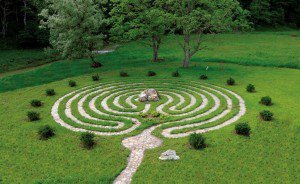
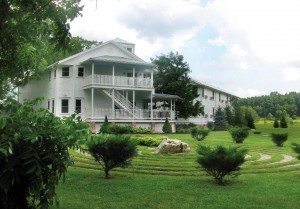
Join Catherine Anderson and me for a three-day exploration of the labyrinth of life in West Virginia’s Inn at Mountain Quest over Labor Day Weekend. There, nestled behind the Inn, awaits a Seven-circuit Classical labyrinth (pictured above).
What’s in store during this retreat
Our time together is designed to empower you to access your inner wisdom and insight as you decide where your next steps will lead. Using photography, storytelling, SoulCollage®, the labyrinth (and more), you will connect to the rhythm of the natural world of which you are an integral part.
This exploration will encourage contemplation and creativity as you expand your boundaries in solitude and in community. This is an opportunity to stretch your soul as you listen to your intuition and explore and embrace the mystery of this journey of life, escorted by Catherine and me.
These photos give you a sense for what awaits you at Mountain Quest’s Inn. Simply click one of the photos to see a larger view.

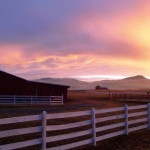
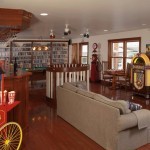

Please arrive any time the afternoon of Friday, September 4 and settle in. We’ll gather for dinner and get to know each other that evening. Checkout is noon September 7 (Labor Day).
About Mountain Quest
In a valley of the beautiful towering mountains of West Virginia, the Inn At Mountain Quest is a tranquil retreat from the ordinary. Centered on 450 acres, the family-owned and -operated Inn centers around a quaint 1905 farmhouse.
A separate modern wing offers 12 uniquely themed guest rooms with common areas such as a recreation center, jacuzzi, sauna, and an extensive private library filled with unusual items collected through years of international travel.
You can read about my recent visit to Mountain Quest in this post.
Pricing
$875 Per person based on double occupancy
Single occupancy (if available) add $165
DOWNLOAD YOUR Spiral Journeys Registration Package
Includes:
Room
All your meals
The use of all public amenities at Mountain Quest
Workshops and group activities
Alcoholic beverages will be added to your tab upon checkout.
EARLY BIRD PRICING is available for those who pay in full by June 15, 2015:
$795 per person based on double occupancy
Add $165 for single occupancy
DOWNLOAD YOUR Spiral Journeys Registration Package
About Catherine Anderson
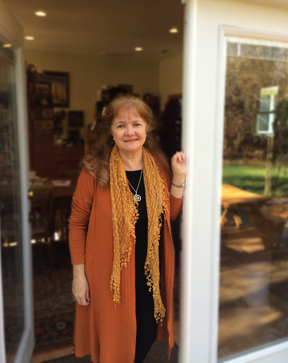 Here’s Catherine Anderson
Here’s Catherine AndersonAuthor of The Creative Photographer and Journaling the Labyrinth Path, Catherine teaches at retreats in Italy, France, Ireland and South Africa, as well as in her studio in Charlotte, NC.
Catherine is a Veriditas Labyrinth Facilitator and SoulCollage® Facilitator Trainer. She believes that the creative process helps us remember what we have come to earth to do, and loves helping others discover their own path to meaning.
She has been a dear friend of mine for over ten years.
The post Join me and Catherine Anderson for “Spiral Journeys” appeared first on Tamela Rich.

May 30, 2015
FAQ: Finding Clean Restrooms, Terrific Welcome Centers
I had a great time in April with my “Ask Me Anything” teleseminar. Questions ranged from how to find clean restrooms to how to travel with pets and inlaws.
Do you have a vacation question for me? Just ask!
The podcast attached to the top of this post captures two of the more lively segments from the session: how to find clean restrooms and the best welcome centers.
Inquiring minds want to know about restrooms and travel plazas
We all want to find clean restrooms, so here’s a secret: don’t limit your possibilities to gas stations and fast food joints. Hotels always have clean restrooms near the front lobby.
Don’t worry, they won’t stop to ask if you’re a registered guest. That said, the restrooms usually have only one toilet for men and another one for women, so don’t take all the kids in at once and draw attention to what you’re doing. Pace your party.
Apps for finding clean restrooms are in this blog, and come with great names: Sit or Squat, Whizzer and Diaroogle.
I can’t vouch for any of them personally, but plenty of moms traveling with kids have. If you end up using any of the apps, please let me know your experience.
About those welcome centers and travel plazas: they’re a great way to collect brochures that will entertain the kids and involve them in the trip. I talked about letting kids have a say in travel planning in this TV appearance.
Click here to view the embedded video.
Welcome centers and travel plazas/truck stops mentioned in the “Ask Me Anything” teleseminar
List of welcome centers by state
Albert Lea MN has “Trail’s Travel Center”
Pelican Truck Plaza in Billing, MTs has the best homemade pie. Recommended by locals.
Chamberlain SD has a super interpretive center at their rest stop
Great one in Pocomoke City MD Worcester County. Knew the ferry schedule to New Jersey
Tamarack in Beckley WV
Tioga Welcome Center Pennsylvania
Once again, you can listen to the podcast above or subscribe to my podcast on iTunes and Stitcher.
I’ll be back with more from my Ask Me Anything teleseminar soon. If you would like to listen to the entire segment and get all the resources covered in the seminar, simply ask me by hitting this link.
The post FAQ: Finding Clean Restrooms, Terrific Welcome Centers appeared first on Tamela Rich.

May 28, 2015
Vacation Makeover: Solve 5 Common Vacation Problems
All too often vacations—even holiday weekends—don’t meet our expectations. The kids are bored and grouchy, you’re overrunning your budget, and the amusement parks are beginning to look the same.
Does it really have to be this way?
Here’s how families can transform their next vacation into one that is peaceful, planned, and has a renewed purpose. When you solve these five common vacation problems you can easily transform your next trip.

Problem: The vacation budget always gets out of control
Solution: Eat at farmers markets and grocery stores, and camp
Stick to healthy foods. Takeout from a local farmers market or grocery store gives you the ultimate flexibility on what to eat. You can select a beautiful site to enjoy your picnic. Bonus: everyone can choose their meal, from sushi to mac and cheese, yes even from a farmers market. I talk about this (and more) in this TV interview.
Click here to view the embedded video.
Try camping. If you don’t want to pack a tent, many KOAs have cabins with linens, fully-stocked kitchens, heating and air conditioning. Bonus: there are always other kids in the campground to play with. A few hours of romping on the playground is a great way to work off the energy that has accumulated in the back seat.

Problem: What can we do that we haven’t already done?
Solution: A road trip with a theme
Pick a theme that your family is interested in, such as dinosaurs, the Trail of Tears, or your personal genealogy, and visit relevant sites that can educate, entertain and enrich everyone in the family. Listen to audio books from the public library or Audible.com based on the region you’re traveling and the theme of your vacation. Conversations will ensue as you listen together.
Vacations are a perfect opportunity to experience another culture and to foster interest in topics ranging from history to geology. If you’re headed to a family reunion, plan a road trip that follows where your ancestors have lived. Fun and education can easily go together.

Problem: The kids are bored
Solution: Let them help plan and navigate the trip
Involve kids of all ages. There are dozens of ways to do so. An older child can research roadside stops or a destination city using apps and websites. While traveling, younger children can help choose restaurants or where to eat a picnic lunch. Everyone likes to have a say and be involved, even (especially!) kids.
Here’s a TV interview that goes into more detail.
Click here to view the embedded video.

Problem: Not enough room in the car
Solution: Pack like Lego pieces
Standardize and minimize. Give each child the same size luggage, pillowcase or plastic bag and a checklist for what to pack. Think of clothing like Lego pieces, any top should go with any bottom. Pack enough to wear for three days and then wash the clothes—hotels and KOAs always have laundry facilities. Here’s a video where I show you how this works.
Click here to view the embedded video.

Problem: We come home exhausted at the end of each vacation
Solution: Don’t plan more than one major activity per day and leave 50% of your day unplanned
Leave time for Road Magic. Stopping the car to take a picture of a hot air balloon, meeting someone with an exotic pet at an unplanned rest stop, or simply lingering at a planned destination allows for Road Magic to happen.
Sometimes the Magic happens inside the car, within the family, thanks to that shared experience. It is the opposite of how we schedule our kids and lives the other 51 weeks of the year.
The post Vacation Makeover: Solve 5 Common Vacation Problems appeared first on Tamela Rich.

May 13, 2015
Why You Need at Least Three Days to Explore Yellowstone National Park
Yellowstone National Park is an American icon. It’s what comes to mind when you think about a national park.
With summer vacation planning in full swing, I’m begging you not to shortchange yourself when you visit. Three days is the minimum stay, but spend five if at all possible. Matt and I explored the park for five days and could spend another five on our next visit!


Bison are the symbol of Yellowstone—and they are everywhere—but until you visit the park and its excellent interpretive centers (discussed below) you may not realize that Yellowstone sits atop one of the world’s largest active volcanoes. Yes, active.
The entire park sits in the depression left behind after a massive volcanic eruption. Geologists call the depression a “caldera.”
Yellowstone’s volcanic history and future

A scientist recently used seismic imaging to map the region and discovered a deeper magma reservoir below the one they already knew existed.
When—not if—Yellowstone National Park erupts again, that deeper reservoir holds enough magma to fill the Grand Canyon eleven times.
I’ll pause while you take that in.
The US Geological Service (USGS) says Yellowstone’s next eruption is likely to be hydrothermal—from shallow reservoirs of steam or hot water—rather than molten rock. When you explore the park’s famous geysers, hot springs, and fumaroles that prediction makes sense (scroll down for some of my photos of each).
There are hundreds of places where visitors are warned not to step or walk because the crust is thin and you could fall through to a boiling death.
Comparing Yellowstone’s eruptions to Mount St. Helens’
The Canyon Visitor Education Center is the place to explore Yellowstone’s supervolcano and other aspects of its geology. It does a beautiful job of putting the forces of nature that created the Yellowstone caldera into context for non-geologists like me.
 For example, if you aren’t familiar with the magnitude of the Mount St. Helens eruption in 1980, please familiarize yourself with it in this story and video. The Canyon Visitor and Education Center provides a visual contrast between Mount St. Helens’ eruption and each of Yellowstone’s three eruptions—which dwarf it.
For example, if you aren’t familiar with the magnitude of the Mount St. Helens eruption in 1980, please familiarize yourself with it in this story and video. The Canyon Visitor and Education Center provides a visual contrast between Mount St. Helens’ eruption and each of Yellowstone’s three eruptions—which dwarf it.
The cube to the left represents the quantity of ash that erupted from St. Helens. Now, compare it to the three large cubes in the picture below. See the corner cubes outlined in red? That’s the relative size of the St. Helens ash emission.
One St. Helens cube is 1/1000 the size of Yellowstone’s last eruption 640,000 years ago and 1/2500 of what erupted 2.1 million years ago.
This stuff enthralls me as an adult, and I am sure it would have been even more fascinating as child.
Please parents, take your kids to national parks. You could awaken in them a love for science that textbooks will never instill. And what kid doesn’t need some relief from the high-stakes-testing factories that schools have become?
Four reasons to spend a week in Yellowstone National Park
Understanding the supervolcano that formed Yellowstone’s caldera is just one example of how you could spend half a day in Yellowstone. Here’s why you need several days with the park.
#1: Yellowstone is huge. Larger than Delaware and smaller than Connecticut, the park is 3,468 mi². It takes some time to explore if you want to do more than step inside and say you’ve been there.
Yellowstone’s size is why it’s not readily apparent that you’re in a caldera—you can’t see to the other side of it!
 #2 Wildlife first. More than anything, Yellowstone is a nature preserve, and that’s why it isn’t paved with four-lane highways and an outer-belt.
#2 Wildlife first. More than anything, Yellowstone is a nature preserve, and that’s why it isn’t paved with four-lane highways and an outer-belt.
Wildlife takes precedence to every human activity. Whenever there is an animal sighting—and there are many—traffic will come to a standstill.
Yellowstone is home the the largest concentration of mammals in the lower 48 states. Most often you’ll see bison, pronghorn antelope and elk, but occasionally you’ll see bear. Although these animals have become pretty tolerant of bystanders, don’t push your luck. Obey the park ranger who is inevitably standing by making sure traffic creeps along and nobody gets hurt.
You have to plan your visit really well—entering the more remote areas of the park—and you’ll need to have a lot of luck to see wolves, mountain goats and bighorn sheep. Binoculars will help.
3. Take your time. While the park has a maximum speed limit of 45 mph, don’t count on going even that fast for any stretch of time. During the high season crashes are frequent because drivers are distracted by the sights or are exceeding the safe speed and whack into someone around a blind curve. When this happens, it can take literally hours for rescue vehicles to get to the scene.
For these reasons, the National Park Service recommends allowing 4-7 hours to drive just “The Grand Loop.”

That said, there is much more to visiting Yellowstone than driving around it. Get out of the car. Hike among the geysers. Go fishing in the Madison. Watch the Yellowstone River fall into the Grand Canyon of Yellowstone (see above a the top of this post). Flop down in a field of wildflowers and have a nap.
Modern people are suffering from nature deprivation, according to Richard Louve, who studies and writes about this extensively.
“The future will belong to the nature-smart—those individuals, families, businesses, and political leaders who develop a deeper understanding of the transformative power of the natural world and who balance the virtual with the real. The more high-tech we become, the more nature we need.” ~Richard Louve
There is even a field called “ecotherapy” that helps us restore wellbeing through contact with nature. Maybe some day your doctor will say, “Take a two-hour hike and call me in the morning.”
4. You’ll love the visitors centers. They’re staffed by knowledgable staff who truly delight in answering your questions and suggesting ways to make your visit more meaningful. A guided visit with a park ranger can be a rewarding and enlightening experience.
Old Faithful Visitor Education Center is where you’ll learn about hydrothermal features that produce the other-worldly-looking geological features in the gallery below.
NOTE: You can click on any of the photos and they’ll pop up for better viewing.
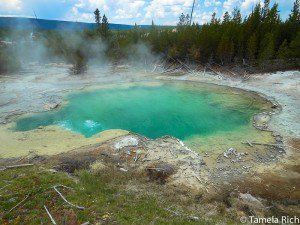
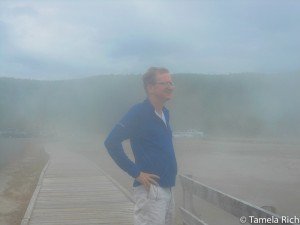
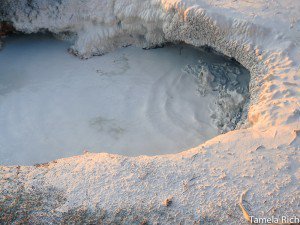
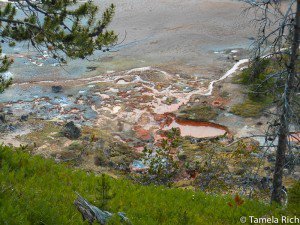
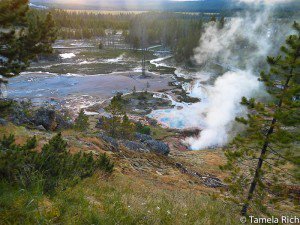
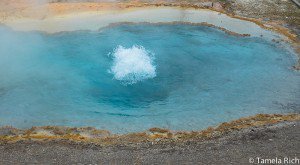
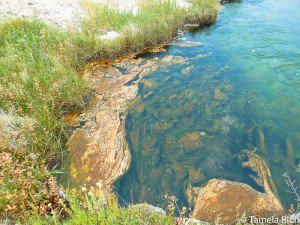
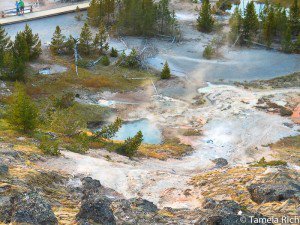
Yellowstone is always letting off steam. See Matt shrouded in it above?
We visited in mid-July and the temperatures varied a great deal, from hot to cool. Pack layers of clothes.
Other Yellowstone visitor centers
Mammoth Visitor Center. Park information, a bookstore, trip planning, and ranger programs.
Fishing Bridge Visitor Center. Exhibits about the park’s birds and other wildlife, and Yellowstone Lake’s geology, including a relief map of the lake bottom.
Grant Visitor Center (also covers West Thumb area). Exhibits describe the park’s historic fires of 1988
Madison Information Station and Junior Ranger Station. Learn more online about the Madison area National Park Service visitor facilities.
Norris Geyser Basin Museum and Information Station. Information, bookstore, and exhibits on the hydrothermal features of Yellowstone.
Old Faithful Visitor Education Center. Yellowstone’s newest visitor center offers dynamic exhibits about hydrothermal features.
Geyser eruption predictions are calculated during visitor center hours and shared on signs, by telephone recordings at 307-344-2751, or via @Twitter.com/GeyserNPS
There’s more to see in the area than the park itself
We camped at KOA in West Yellowstone, Montana. The town has a great deal to offer, including the Grizzly and Wolf Discovery Center, where I’d recommend spending at least two to three hours in the morning at feeding time. This is not a zoo; it’s a place where animals who can’t survive in the wild are given a life that resembles the wild to the extent humans can make it possible. What you learn there will enhance your visit to the park.
Northeast of the park is Cook City and other little villages. Plenty of fishing lodges and some terrific motorcycling roads en route to Red Lodge, MT by way of Beartooth Pass and Cody, WY via my favorite road, Chief Joseph Highway.
If you have questions or comments about Yellowstone, please comment.
The post Why You Need at Least Three Days to Explore Yellowstone National Park appeared first on Tamela Rich.

May 5, 2015
Explore Pocahontas County, West Virginia by Motorcycle
There’s nothing like early spring in the Appalachian Mountains! Frosty mornings, sunny afternoons, and gorgeous sunsets that you can watch through trees whose branches aren’t yet covered in leaves all remind you that it’s great to be alive.
Here’s a ride report from my trip through Pocahontas County, West Virginia in April 2015.
I met my pal Jill in Sutton WV on a Friday evening and the next morning we meandered through the Monongahela National Forest to Marlinton for a late lunch at the Greenbrier Grille and Lodge in Marlinton.
Motorcyclists will admire the twisties along our route!
Marlinton stays strong despite floods and fire
Jill and I took our time exploring the Pocahontas County Seat of Marlinton, which saw its first white settlers in about 1749. By 1910, Marlinton had a tannery, two banks, two newspapers, about 20 stores, a hospital, opera house, volunteer fire department, school, water system, electric power, and a population of 1,086.
Richardson Hardware
Today, despite devastating fires and floods that wiped out most of the other institutions, CJ Richardson Hardware and Furniture stands tall, the oldest surviving building in the town.
You have to be “a certain age” to appreciate a genuine hardware store where people know how deep the frost line is and give you a handwritten receipt for your purchases. The staff is friendly and proud of the store’s history. Its Yelp reviews tell it all.
Click any of these photos and they’ll pop up so you can examine them more closely.
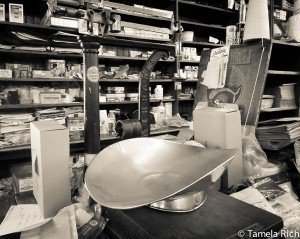


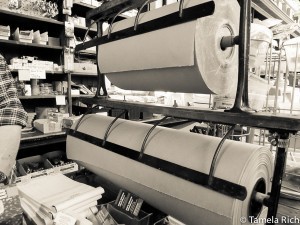
Marlinton Opera House
Built in 1910, The Marlinton Opera House serves the community to this day, not with opera, but with a diversity of cultural events. Jill and I were there in time to watch a Beatles/Grateful Dead tribute band “Long Strange Night” warm up and do its sound check.


The pressed-metal ceiling panels are in pristine condition, and I was surprised to learn that the balustrade surrounding the balcony is American Chestnut.
A word about the American Chestnut, which was once vital to the Appalachian economy and way of life. These trees were among the largest, tallest, and fastest-growing in the eastern forest. It fed people and animals. The blight that destroyed them has been called the greatest ecological disaster to strike the world’s forests in all of history. This video gives a recap of its demise and efforts to bring it back.
Post office art
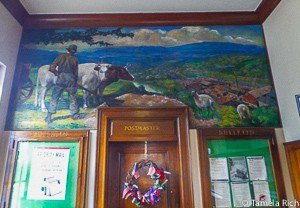 Marlinton PO mural
Marlinton PO muralWhenever I’m in old towns I like to see if the post office has WPA art, and sure enough, Marlinton had a bucolic scene over the Postmaster’s office door. “Past Visions the Future” by Edwin Dorsey Doniphan (1939) hangs in the lobby (funded by the Section of Fine Arts under the Treasury Department, not the WPA).
Two modern murals
Artist Molly Must painted two striking murals on the sides of Marlinton buildings. “Over Bonnie” (pictured at the top of this post) greets you as you cross the Greenbrier River bridge from Rte 39/55.
It illustrates the transformation of Appalachia in the 19th and 20th centuries. The mural features the poems and sentiments of Louise McNeill, a WV poet laureate who grew up in the area.
If you follow this ink, you can scroll over different parts of the mural for background on what you’re seeing and its significance. It’s a treat.
 “Civil War” mural by Molly Must in Marlinton WV
“Civil War” mural by Molly Must in Marlinton WVMarlinton’s other mural by Molly Must, “Civil War,” is focused on the hardships faced by those who stayed at home. It reminds passersby that West Virginia became a state in the War Between The States. The mural’s primary color is red—for spilt blood?
Again, click through to interact with the mural and learn what its parts meant to the artist. Ms. Must is living in Asheville, NC, not two hours from me. I’ll look her up next time I’m there!
Mountain Quest Inn and Institute
I was eager to get to know the owners and staff at Mountain Quest in the nearby Frost community. I will be hosting two retreats there this year.
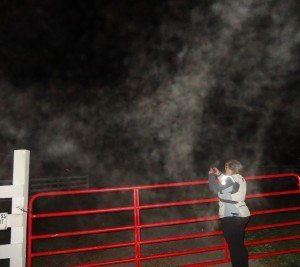 Me in Mountain Quest “Myst”
Me in Mountain Quest “Myst”I knew from the website that the Inn is lovely, but nothing prepared me for what I experienced with Dr. Alex Bennett after dinner.
With no light pollution, the night skies at Mountain Quest are black, save for the diamonds strewn across the Milky Way by the hand of our Creator.We carried our cameras out in hopes of catching orbs and “myst” under the stars.
I definitely caught some orbs but the picture below, taken by Alex, shows myst all around me! I was completely unaware of the bigger picture—and isn’t that a metaphor for life!
The concept of “myst” goes far beyond what I can cover in this post, but an article in the Pocahontas Times does it beautifully. Alex’s book, Journey Into the Myst, does so in great detail.
Jill left for home Sunday and I had the day alone to explore the grounds at Mountain Quest waiting for my friend Joanne aka “Gear Chic” to arrive. I hiked up the ridge that surrounds the property and flopped on the ground, basking in the sun and silence.
Okay, not silence…I could hear leaves rustling in the breeze, crows calling to each other, and birdsong. Heaven.
I posted a video of Mountain Quest’s deer herd (on my Facebook page) galloping across the frosty meadow then jumping the fence into the next pasture. Here’s a gallery of photos from my visit with both Jill and Joanne. Mountain Quest is home to ten horses, two llamas, long-horned cattle, a sheep and “Red” the goat.
Click on one of the photos to get a larger view.
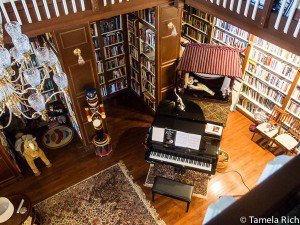
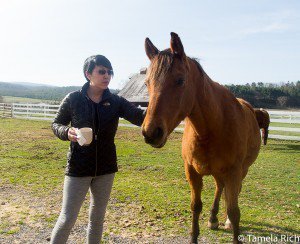
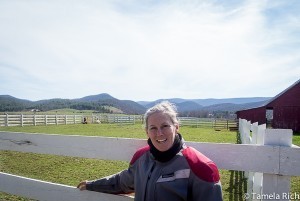
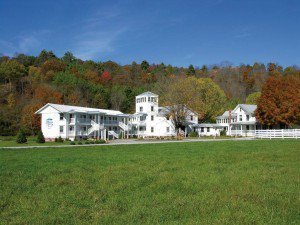
Highland Scenic Highway
Joanne and I set out on Monday to tour more twisty and scenic roads. We ended our day on the Highland Scenic Highway, a National Forest Scenic Byway and the highest major roadway in West Virginia. I consider it a “must see” for everyone, no matter the number of wheels on their vehicle.
We parted ways on a rainy Tuesday, happy to have scored a perfect gap of fine weather to explore Pocahontas County in early spring. I’m looking forward to many happy return visits!
 Highland Scenic Highway
Highland Scenic HighwayIf you’ve traveled in this region, please tell me your favorite spots. As always, if I can help you plan YOUR getaway, please be in touch.
The post Explore Pocahontas County, West Virginia by Motorcycle appeared first on Tamela Rich.




